#William Matthew Prior
Video
youtube
Portraits in Eve's Bayou
Just a quick historical tidbit about a pair of portraits I spotted during my most recent Eve's Bayou rewatch.
25 notes
·
View notes
Text
100+ Famous Modern Art Artists of All Time

2/8/2024
♦ Framed Poster Print
♦ Canvas Print
♦ Metal Print
♦ Acrylic Print
♦ Wood Prints
🌐 Worldwide shipping
#William Matthew Prior#sonia delaunay#Perle Fine#john currin#alma thomas#jay defeo#theo van doesburg#barnett newman#frank stella#juan gris#robert motherwell#Bradley Walker Tomlin#cy twombly#lee krasner#franz kline#Lyubov Popova#clyfford still#bridget riley#sam gilliam#františek kupka
4 notes
·
View notes
Photo
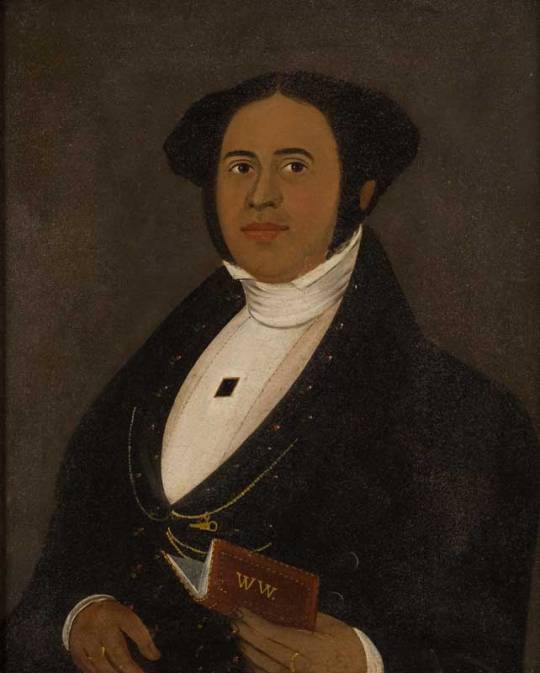
William Whipper, attributed to William Matthew Prior, 1835
#William whipper#attributed to William Matthew prior#attributed#William Matthew prior#prior#1835#1830s#1800s#19th century#portrait#painting#art
5 notes
·
View notes
Text
The Pines of Rome Interview: Sounding the Alarm
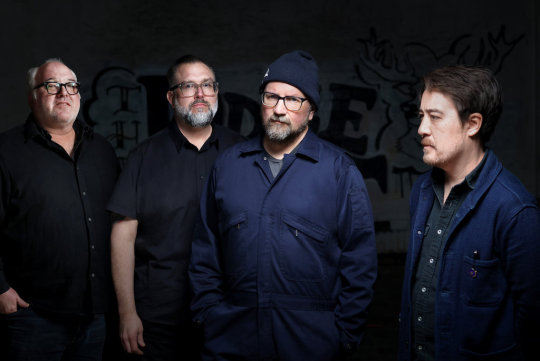
BY JORDAN MAINZER
Some reunions happen off the cuff, a band simply finding themselves in the same room again, missing what they had and immediately deciding to get back together. Others, like that of Rhode Island slowcore band The Pines of Rome, seem to happen over a number of years, a result of shifts in modes of thought. Yes, the pandemic caused guitarist/vocalist Matthew Derby to finally reach out to guitarist John Kolodij, but events in his circles both close and broad was what lit the spark.
20 years ago, The Pines of Rome played what was then supposed to be their final show. While they were never a political band, Derby was always involved in the local arts community in Providence, a scene that’s long been uniquely closely intertwined with political organizing through organizations like AS220. Over time, though, not playing music, Derby became less and less involved, ultimately feeling “detached,” as he told me over the phone earlier this year. A day after Donald Trump was inaugurated, one of the stalwarts of the local arts community, writer and activist Mark Baumer, was killed by an SUV while walking barefoot across America to raise awareness of climate change. Though Derby mourned Baumer’s death, he took the time to self-reflect and started to become involved again in the local arts community. And when he started writing songs again, he knew he had to write one about Baumer, which turned into “I am a road”, the first track on what would be come the first The Pines of Rome album in 20 years, The Unstruck Bell (Solid Brass).
After Derby and Kolodij started jamming, they contacted the band’s drummer Rick Prior and recruited a new member, bassist Steven Kimura. They entered the studio with prolific producer Seth Manchester, knowing they had something, not necessarily an album, but a collection of songs that at least continued on the post-rock journey they paused decades prior. “The By & By” featured an interplay among exploding distortion, mammoth snares, and gentle harmonics. “Slick Enhancer” was deliberate, too, featuring guitars that were at once rounded and raw. The comparatively twangy “White Ships” chugged along, but used silence and space like you’d expect from a band inspired by the slowcore acts of the early 90′s. Eventually, though, they decided to shake things up a little bit. “REDACTED” spotlighted shuffling electronic tape loops. “Siren” and “I am a road” featured acoustic, finger-picked guitar. With a little bit of reigning in from Manchester during times they wanted to go too over-the-top with instrumentation (Derby recalls the band wanting to put a harmonium on “I am a road” simply because it was there in the studio, Manchester standing firm and saying no), it turned out The Pines of Rome did, in fact, have an album. The Unstruck Bell was released in May.
The Pines of Rome also have returned to the stage, playing with contemporary kindred spirits like Cloakroom and an album release show at the Columbus Theatre in Providence last month. But before Derby even practiced for those shows, he started writing new material. The band plans to go back in studio with Manchester later in the year. He’ll probably have to be honest with them about their loopiest instrumental ideas. In the meantime, though, they were able to do what they wanted live, and yes, their sets purportedly included a full-band version of “I am a road”.
Read my interview with Derby, edited for length and clarity, below. He speaks about how it feels to be back, the state of post-rock, political music, and being inspired by new bands.

Since I Left You: Despite the presence of your new band member, does it feel like you never left? Or are you starting anew?
Matthew Derby: There is an element of that kind of cliché. There’s just something about the way John and I write. There’s some alchemy happening with our two guitar parts I’m never able to replicate on my own. When I try to write my own stuff, it ends up sounding like the worst kind of Journey ballad, which is dignifying them too much. Neither of us were able to achieve on our own what we got out of playing together. When John and I started playing again, we picked up right where we left off, and it was a tremendous relief. I didn’t know what I was missing. It felt really powerful to be able to have that articulation or musical language that really only works when we’re collaborating.
SILY: Do you feel like you had any newfound inspirations or influences this time around, whether instrumental, thematic, and/or lyrical?
MD: That’s a really good question. Definitely, in terms of influences, in our first incarnation, the combination was largely the Saddle Creek-style folk stuff that was happening in the late 90′s, and post-rock, which we were really heavily influenced by, bands like Rex, June of 44, and Bedhead. We were trying to combine those two influences. In the 90s, [I thought] that post-rock bands [were] going to stay around and keep making music forever, and [the] new form [would] become folk or jazz or whatnot. Five years later, it was gone completely. All of those bands disappeared. In a way, we started [The Pines of Rome] again because we were missing that. I personally wanted more of that kind of music in the world. At the same time, our tastes have changed over the course of 20 years. The genre striation that was around in the 90s has given way to a much more permissive musical culture, where genre distinctions are quaint and old fashioned. One of the bands we look to as a model stylistically and lyrically and musically is Big Thief. They’ve merged so many genres into this new Americana that’s hard to pin down and describe but feels very much like their creation.
SILY: Post-rock can go two ways, as does slowcore. The Bedheads of the world get the Numero Group treatment, while the cleaner, atmospheric bands like Explosions in the Sky or Mogwai soundtrack commercials. And sometimes you can get more metal or jazzy with it. Do you feel like that’s true to the spirit of the original post-rock, this genre-less style of music?
MD: I don’t know that I would have articulated it that way, but it’s a good summary. There’s more to explore in that space, and we felt compelled to push it in new directions but also retain whatever unique spin on it we could provide to add our voice to the chorus of people still trying to explore that stylistic train.
SILY: The bands that endure or endured, like Low, Yo La Tengo, and Lambchop, are unafraid to embrace things once looked at as cheating, like AutoTune and drum machines, and put it in their music in a tasteful way. It speaks to that lack of purity you refer to.
MD: Invoking genres [in general], there’s a way in which, like AutoTune, you’re bringing in a stylistic quality that’s been celebrated and maligned. Once the hype and the backlash has died down, it’s another way bands can express themselves. When John and I started playing again, one of our rules was, “If it feels good, keep doing it.” It seems like the most obvious aesthetic you could possibly make, but the initial hesitation of, “Are we just going to sound like Bedhead?” or any band popular 20 years ago that sound really dated, was replaced by, “Let’s just pursue this to our logical conclusion.” Run through our filter, it might not sound like anything we’re afraid of imitating.
SILY: Is there a song on the album where the rule of, “If it feels good, keep going,” led to something unexpected?
MD: The first few songs that we wrote were the last song, “Slick Enhancer”, and “White Ships”, which are slow tempo, open and spacious, with this culmination in big, crashing tsunami waves. To us, that was where we naturally go. We started, and thought, “Let’s go with it. This is what we do.” We play these slow, deliberate songs where we carve out negative space and fill it in at dramatic points in the song. Then, we thought, “Uh oh, we’re on the verge of writing a fourth song that does that same thing.” At that point, we deliberately changed course. There definitely is a point where you have to break your own rule because you don’t want to make every song on the album sound the same. We started to challenge ourselves. We said, “Let’s try to write a song in a completely different style.” Someone said, “Let’s write a krautrock song!” John started to come up with a riff that eventually turned into “Redacted”, which is not something anyone would listen to and say, “This sounds like Neu!” Its genesis, though, came from our desire to not want the album to be one note and to explore a different sonic terrain. We took a left turn, and what came out is not at all what we tried to put in, which was a lesson to us. We can try to deliberately rip off anyone we want, but it will always come out the other end sounding like what we do. We loosened up, and have been doing a lot more of it since the album was recorded.
SILY: In hindsight, that shuffling at the beginning of “Redacted” reminded me a little of maybe not Neu!, but Tortoise. It does chug along.
MD: Yeah. The initial impulse was the song “Hallogallo” from the first Neu! album. We originally played it where we all had volume pedals and tried to manually ramp up the volume. It was originally 8 minutes long and...started with the drums barely playing. [When] we brought it into Machines with Magnets, Seth Manchester said, “Guys...I don’t think this is the spirit of the song. Let’s find another way in.”
SILY: It’s an effective second single, though, because if the first taste of the new music was “Slick Enhancer”, which sounds like you never left, this one is a bit more unexpected.
MD: That was what we were hoping. I’m glad that came across.
SILY: What’s the inspiration behind the lyrics of “I am a road”?
MD: There was a poet and activist in Rhode Island who used to teach at Brown, Mark Baumer. He was a really influential creative person in the Providence arts community in the early 2000s. He was in the MFA Program at Brown and taught poetry. He was rigorously experimental and did all kinds of weird things. One day, he showed up to his poetry class in his coveralls and just cowered in the corner and pretended to be scared of the class, and that was his poetry class. He was also really involved in organizing. He was part of this group called The FANG Collective, an abolitionist group. They were originally protesting the [Iraq War] and [War in Afghanistan], and he actually chained himself with a bike lock to the door of the headquarters of Textron, a company in Rhode Island building cluster bombs causing horrendous collateral deaths in Afghanistan. He was arrested for that.
He was a really influential figure. I knew him and was always kind of intimidated by him. We’d go to readings together, and I’d say a few words to him. He had this practice of walking across America barefoot to bring awareness to climate collapse. He went around the country once and raised a bunch of money. In 2016, around the time of Trump’s election, he went out again, and on the day Trump was inaugurated, he was hit by a car and killed. To me, it really felt like he was the first casualty of the Trump administration. The whole Providence arts community was totally heartbroken. It was the beginning of my realization that I had given up a lot. We had stopped playing in the band, and I had drifted away from the Providence arts community. I had become detached. It was a wake up call. I became more active in local organizing and the Providence arts community. The song came out of that.
[Mark] was also an early vlogger. He has hundreds of videos of himself going across America. There is this last video of him on the day he was killed. Because that was the start of a change in me, I used that as the material for that song.
SILY: Are you still involved in AS220?
MD: Not really. Friends of mine are. They’ve gone through a bunch of radical changes over the past 10 years. They’re doing amazing work.
SILY: What sorts of changes?
MD: They’ve always been about supporting the arts community, but once Trump got elected, [they started to ask questions like,] “Whose community are you representing here?” They’ve taken huge strides in becoming inclusive and representing and inviting a greater and more accurate version of what the Providence arts community looks like, demographically and politically. Those things weren’t on the table prior to this recent spade of changes.
SILY: What’s the inspiration behind the record title?
MD: It’s related in a way to “I am a road” and the influence that Mark had on me. We were thinking about the idea of this alarm that hasn’t yet sounded. The potential that a bell holds. It’s a little pretentious, but the bell has all of the potential in it to sound the alarm, but someone needs to strike the bell in order for the alarm to sound. It was a gesture at this moment. John doesn’t want me to reference the pandemic, for good reason. This isn’t a “pandemic record.” The effect the pandemic had in something is undeniable, and we felt like we were experiencing in real time this climate crisis, and it’s possible that we’re already living in a climate apocalypse and we just don’t know it. That’s where that concept of the unstruck bell came from.
SILY: I don’t know whether this album is your attempt to sound the alarm, but, at the risk of sounding reductive, it’s interesting that this style of music could sound an alarm, this slow music. Do you think about that?
MD: Yeah. It’s something I struggle with a great deal. I do recoil at music that is overtly political or tries to push an agenda. My aesthetic sensibility tells me to stay on the John Prine end of the spectrum of making a song that might plant a seed in someone’s mind that would motivate them to take some kind of action, but not urging them to do so. Slowcore and post-rock aren’t traditionally the vehicles--you’re not going to go to a protest and start singing songs from Spiderland. It’s not really attuned to that. But as I’m getting older, the ways in which all of these systems are interconnected, I’m interested in that place where we can create something aesthetically interesting and new [that] tries to take genre tropes in a new direction. Part of that new direction asks, for instance, “Can we just write a simple love song in the time we’re living without it spilling over into all of the other things going on in the world?” It’s something I think about a lot, and I don’t know that we’ve carefully delineated the Venn diagram of talking about and raising awareness of an issue and songcraft, trying to make a song that people want to sing around a campfire. I don’t know where we fall in that.
SILY: If one of the main purposes of art is to create empathy, which I think is inherently political, the observational, humanistic, earthbound songwriting of John Prine falls into that. At the same time, music that’s slower in pace that requires patience to listen to deeply, there’s an inherent humility in that act, too. That’s where I see the Venn diagram.
MD: I really love what you said about patience and listening. Trying to slow things down is an act alone that triggers a different way of thinking. That’s really beautiful.
SILY: It can exist at the same time as the urgency. It has to.
MD: Totally.
SILY: What’s the story behind the cover art of the record?
MD: John is friends with Will Schaff, the artist. We’d been an admirer of his work. He did the [art for the] Godspeed You! Black Emperor record, [Lift Your Skinny Fists Like Antennas To Heaven]. He did a [Songs: Ohia] record. He also started to embroider during the pandemic and would post these works he’d been doing on Instagram. I grew up in a Catholic family, and my mom was really involved in the church, and she did a lot of banners and tapestries for the church. The embroidery kind of recalled some of that work. We didn’t really think it through that much, and we gave Will the album title. I think John gave him the songs in their raw state and asked him to make an interpretation. That’s what he came up with. It was a collaboration without constraints. I really love how it came out.
SILY: Do you know what shape your new songs will take?
MD: This might end up being super pretentious and we might back away from it, but our goal is still to split the record sonically between one side all acoustic and the other all electric, as an organizing principle. That’s helped us shape the songs. We found that there were certain things we could get away with stylistically in an acoustic setting we weren’t able to do with a full electric setup. We may continue down that path, but [it could be] a cool idea that has no substance. We do plan to record a bunch more acoustic songs this time around. We’re trying to push out on both ends of the spectrum. We have songs that are a bit more aggressive, like the big middle third of “Slick Enhancer”, and much quieter songs. We’ve really been into the band caroline, and the way they’re able to play this one riff for 7 minutes and make this hypnotic hymn out of it with different movements. I don’t know how they do it, but we’re experimenting with songs closer to that feel.
SILY: What else is next for you?
MD: We’re trying to figure out whether we can get out on the road. Solid Brass, the label that put the album out, are awesome. They’re good friends of ours from a long way back. They’re also just starting up, figuring out how to work a label. We’re trying to figure out to what extent we’ll end up able to get on the road. Honestly, to me, when we re-joined, my single ambition was just to play with the band again and start writing and recording songs. We didn’t have any aspirations of putting a record out, even when we first recorded with Seth. We love working with him and just booked time for the pure enjoyment. We’re trying to keep that same spirit for the next record, keeping expectations of where it will go out of the equation. Once I start thinking about that stuff, it makes it harder to write the songs we want to record and that we’ll have fun playing and figuring out.
SILY: Anything else you’ve been listening to, reading, or watching you’ve enjoyed?
MD: We’ve been super into the band Wednesday. It was one of these moments where they’ve found a way to perfectly merge shoegaze and country music that felt surprising and cool. The lyrics are the best kind of David Berman, incredible plays on words, clever and funny while totally heartfelt and devastating. It’s a lot of what I aspire to and am still working toward.
SILY: A quintessentially Southern voice.
MD: Yes! And not a cliched one. Crystal clear in terms of the poetry and lyricism of it.
youtube
#the pines of rome#interviews#john kolodij#solid brass#rick prior#seth manchester#machines with magnets#the fang collective#william schaff#the unstruck bell#matthew derby#as220#mark baumer#steven kimura#cloakroom#columbus theatre#journey#saddle creek#rex#june of 44#bedhead#big thief#numero group#explosions in the sky#mogwai#low#yo la tengo#lambchop#neu!#tortoise
0 notes
Text
Every Literary Reference Gale Makes When Selected in BG3 (That I Could Find)
"Oh, what a tangled Weave we web!" -
A play on words referencing the famous quote, "Oh, what a tangled web we weave when first we practice to deceive," from Sir Walter Scott's poem "Marmion."
"What fools these mortals be." -
A quote from William Shakespeare's play "A Midsummer Night's Dream," spoken by the character Puck.
"All the world's my stage and you're just a player in it." -
A reference to the famous Shakespearean line, "All the world's a stage, and all the men and women merely players," from "As You Like It."
"No rest for the wicked" -
A phrase that originates from the Bible Isaiah 48:22 There is no peace, saith the Lord, unto the wicked.
"To hold the world in the palm of one's hand" -
I believe this is a reference to this part of the poem Auguries of Innocence by William Blake:
To see a World in a Grain of Sand
And a Heaven in a Wild Flower,
Hold Infinity in the palm of your hand
And Eternity in an hour.
"'Doth thy mirror crack?' Apparently not." -
I was so sure this was a quote from some Shakespearean play but nope lol. This is a Waterdhavian phrase that was mentioned in a DnD companion book at some point.
"Seek and you shall find me." -
From the bible. Specifically Matthew 7:7–8
Ask, and it shall be given you; seek, and ye shall find; knock, and it shall be opened unto you: for every one that asketh receiveth; and he that seeketh findeth; and to him that knocketh it shall be opened.
The path less travelled. -
A reference to Robert Frost's poem "The Road Not Taken," which includes the line, "Two roads diverged in a wood, and I—I took the one less traveled by."
"Creator. Destroyer." -
This is a reference to the Lord Krishna's words in the Bhagavad Gita.
O Arjuna, I am the creator, maintainer and destroyer of all created objects, such as the sky. Of all knowledge I am knowledge of the self, and in logical debate I am vāda, the philosophical principle that asserts the conclusive truth.
"A rough tempest I will raise" -
I found the explanation behind this quote from a reddit post:
"Shakespeare - Tempest, - this is a mash-up of two quotes: In Act V, Scene 1, Prospero uses the phrasing "when first I raised the Tempest". In the same scene, he recites a soliloquy about the great works of magic he has accomplished, before finally renouncing magic altogether: " … But this rough magic I here abjure" https://www.reddit.com/r/BaldursGate3/comments/17uher2/literary_references_in_gales_selection_remarks/ (this person came to the same conclusions as me for many of the prior quotes but I only used their post for this one haha)
I almost certainly missed a few! If there are any others please feel free to reblog and add them!
#bg3#baldur's gate 3#gale dekarios#gale of waterdeep#literature#bible#bhagavad gita#walter scott#shakespeare#william blake#robert frost
301 notes
·
View notes
Text
trailer 1
[fast times and fast nights]

the 2024 season: deemed silly season by the fans and drivers themselves. for good reason.
questions remain: will mclaren be able to handle their two talented drivers in aella gutierrez and alexis mun? how does red bull manage the background noises of kelly piquet's father when they've got reigning world champion, jupiter nightshade, in their championship winning race car? are mercedes drivers, camellia ayudisha and sonnet pham, still good friends after the mishaps and miscommunications in the 2023 season?
or is that not what you're here for? do you want to look beyond what everyone is already talking about?
are you more curious about max verstappen's budding relationship with kelly piquet after her messy breakup with departed alphatauri driver, daniil kvyat? or mclaren and williams drivers' involvement between aella gutierrez and logan sargeant after the vast differences in their performance during their rookie season? or is it the fact that venus nightshade's current boyfriend, arthur leclerc, typically sighted in the alpine garage last season with joanna matthews, will now frequent the ferrari garage instead? or is it the rumours that alexis mun and, long-term boyfriend, atticus singh allegedly broke up over the winter break? or are you intrigued by prior mercedes reserve driver, mick schumacher, stepping away from the team to join alpine in the world endurance championship, as his girlfriend, sonnet pham, continues to drive for the same team?
could it be that you're wondering how the nightshades are affected after ferrari's mishandling of the rookie's talent in 2023, while the reigning world champion is accommodated by red bull time and time again? or the friendly sibling rivalry as the leclerc's are separated by a wall between their girlfriends' garages on a race weekend?
frankly, we've got the same questions.

#f1 oc#f1 fanfic#f1 fanfiction#max verstappen#logan sargeant#alex albon#george russell#arthur leclerc#mick schumacher#charles leclerc#daniil kvyat#f1 grid x oc#formula one x oc#f1 female driver#f1 fem driver#fem!driver#disneyprincemuke#disneyprincemuke imagine#disneyprincemuke imagines#disneyprincemuke f1#disneyprincemuke ftfn
36 notes
·
View notes
Text


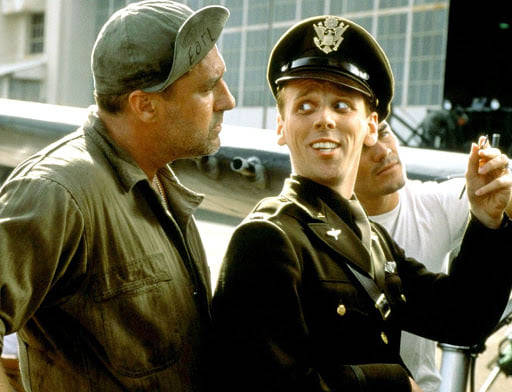



Happy Birthday Scottish actor Ewen Bremner, born January 23rd 1972 in Edinburgh.
Bremner has worked with many of the most respected directors in world cinema, including Danny Boyle, Mike Leigh, Ridley Scott, Joon-Ho Bong, Werner Herzog and Woody Allen. Hen has established himself by creating unique characters in critically acclaimed films, as well as going toe to toe with many of Hollywood's biggest stars.
Ewen had worked widely in theatre, television, and film for years before being cast in his breakout role in Trainspotting, by Oscar-winning director Danny Boyle. He was the first to be cast in the role of Mark Renton in Edinburgh's Traverse Theatre production but lost out to Ewan McGregor in the film version, instead he was handed the role of Spud Murphy and earned screen immortality with his character's infamous "speed fuelled" job interview scene.
Prior to Trainspotting, Bremner gave a striking performance in Mike Leigh's Naked, fellow Scot Susan Vidler played his girlfriend Maggie in this excellent film.
In 1999, Bremner received critical acclaim for his portrayal of a schizophrenic man living with his dysfunctional family in Harmony Korine's Julien, Donkey-Boy. Filmed strictly in accordance with the ultra-realist tenants of Lars Von Trier's Dogma 95 movement and starring opposite Werner Herzog, Bremner played Julien its eponymous hero, requiring him to assume an American accent. He then worked with director Michael Bay in his high-profile 2001 war film Pearl Harbor, proving his versatility once again by portraying the role of a wholeheartedly patriotic American soldier fighting in WWII. The following year, he stepped back into fatigues for a supporting role in Ridley Scott's Black Hawk Down, while rounding out the next several years with roles in high-profile Hollywood releases such as The Rundown, Disney's Around the World in 80 Days), AVP: Alien vs. Predator, Woody Allen's Match Point, the comedy Death at a Funeral directed by Frank Oz, and Fool's Gold starring Matthew McConaughey and Kate Hudson.
This past few of years proved to be a busy when Bremner was invited to join the DC Universe in the Zack Snyder-produced feature Wonder Woman, directed by Patty Jenkins, co-starring Gal Gadot and Chris Pine. Ewen also reprised his unforgettable role as Spud in the highly-anticipated sequel to Danny Boyle's cult classic, T2: Trainspotting
Bremner appeared in the TNT Drama Series Will with Shekhar Kapur. The series told the story of the lost years of young William Shakespeare after his arrival to London in 1589 but only lasted one season. Other notable film credits include Woody Allen's You Will Meet a Tall Dark Stranger, Perfect Sense starring again alongside Ewan McGregor, Great Expectations, Jack the Giant Slayer, and Snowpiercer starring alongside Chris Evans and Tilda Swinton. Further credits include Exodus: Gods and Kings, Wide Open Spaces, Mojo, Mediator, Faintheart, Hallam Foe, Sixteen Years of Alcohol, and Snatch.
In television, Ewen has worked on many acclaimed productions including David Hare's Worriker trilogy starring Bill Nighy for BBC, Jimmy McGovern's Moving On and also his Australian mini-series Banished, Strike Back for Sky TV, Dominic Savage's Dive, the Dylan Thomas biopic, A Poet In New York and the adaptation of Day of the Triffids for the BBC. Other noteworthy series appearances include portraying legendary surrealist Salvador Dali in the U.K. television drama Surrealissimo: The Trial of Salvador Dali, and a guest spot on the successful NBC series, My Name is Earl, not to forget an early appearance in Taggart way back in 1990.
Latley Ewen has been one of a number of Scottish actors who are backing a campaign to reopen the Film House cinema in Edinburgh, he has a couple of projects on the go just now, Bluefish, which takes us around the globe to tell stories of people trying to break out of their bubbles of isolation, which I take to mean the Covid pandemic, he also has a film on the go called Roo, but there is nothing to report on that just now.
21 notes
·
View notes
Text
Espionage and pedo.
Many good articles on this guy and what he did including encrypting tens of thousands of pics and videos of horrific sexual abuse of children. Somewhere in all this he got so upset at the cia he sent a bunch of files to Wikileaks. This became the infamous Vault 7 files. This article doesn’t talk about it, but from the Newsmax article on him:
The so-called Vault 7 leak revealed how the CIA hacked Apple and Android smartphones in overseas spying operations, and efforts to turn internet-connected televisions into listening devices. Prior to his arrest, Schulte had helped create the hacking tools as a coder at the agency’s headquarters in Langley, Virginia.
25 notes
·
View notes
Text
OFMD Stede Bonnet as a Macaroni: Wealth, Gender and Sexuality in the 18th Century Fashion World
Historical Inaccuracy in Our Flag Means Death? Never!
Historical inaccuracy! I hear you cry. A Macaroni in 1717!?! It is true macaroni fashion was really a late-18th century fashion trend, seemingly reaching its peak in the 1770s. However Our Flag Means Death is nothing if not historically inaccurate. Stede’s costumes seem to take inspiration from across the 18th century rather than worrying about what would have actually been worn in 1717.
Early 18th century suits tended to have round necklines, loose-fitting sleeves with wide cuffs, long waistcoats that stoped just above the knee, and coats with full skirts just a little longer that the waistcoat.

[Left: Matthew Prior, oil on canvas, c. 1713-1714, by Alexis-Simon Belle, photo credit: St John's College, University of Cambridge, via Art UK.
Middle: Matthew Hutton of Newnham, Hertfordshire, oil on canvas, c. 1715, by Johannes Verelst, photo credit: National Trust Images, via Art UK.
Right: William Leathes, Ambassador Brussels, oil on canvas, c. 1710-1711, by Herman van der Myn, photo credit: Colchester and Ipswich Museums Service: Ipswich Borough Council Collection, via Art UK.]
As the century continued we get standing collars and turned down collars but round necklines were still around as well, sleeves got tighter with smaller cuffs, the waistcoats got shorter and the coats lost their skirts.
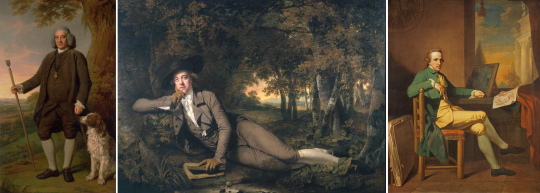
[Left: Thomas ‘Sense’ Browne, oil on canvas, c. 1775, by Nathaniel Dance-Holland, photo credit: Yale Center for British Art, via Art UK.
Middle: Sir Brooke Boothby, oil on canvas, c. 1781, by Joseph Wright of Derby, photo credit: Tate, via Art UK.
Right: David Allan, oil on canvas, c. 1770, by David Allan, photo credit: Royal Scottish Academy/National Galleries of Scotland (Antonia Reeve), via Art UK.]
Stede’s collars are inconstant some are rounded but others are turned down and Ed’s purple suit has a standing collar. Many of Stede’s coats have wide cuffs, but most have little skirt to them. His teal suit from the pilot has a bit of a skirt but its paired with a short waistcoat.

Most of Stede’s waistcoats are short with the exception of his suits from both the wedding portrait with Mary and the the family portrait. Both suits are very straight giving him a boxy appearance and are pretty different from most of the suits we see him in.

All in all I don’t think they were aiming for historically realistic clothes but with the collars, short waistcoats, and lack of skirts I get more of a late-18th century vibe.
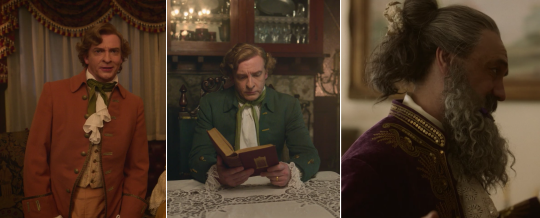
So what was a Macaroni?
A Classical Dictionary of the Vulgar Tongue (1785), defined macaroni as follows:
An Italian paste made of flour and eggs; also a fop, which name arose from a club, called the maccaroni club, instituted by some of the most; dressy travelled gentlemen about town, who led the fashions, whence a man foppishly dressed, was supposed a member of that club, and by contraction stiled a maccaroni.
The macaroni club was said to have comprised of young men who had gained a taste for French and Italian textiles on their Grand Tour (a traditional trip taken tough Europe by upper class men when they came of age). The earliest reference to the club is from a letter from Horace Walpole to Lord Hertford on the 6th Feb 1764:
at the Maccaroni Club (which is composed of all the travelled young men who wear long curls and spying-glasses),
In his book Pretty Gentleman: Macaroni Men and the Eighteenth-Century Fashion World Peter McNeil suggest the club was actually Almack’s. Almack’s was a private club at 50 Pall Mall that was attended by prominent Whigs including Sheridan, Fox and the Price of Wales. (p52) While the name may have originated from the men at Almack’s it was soon used to describe any man who followed the associated fashion trends.
So what were these trends?
Hair
“Still lower let us fall for once, and pop
Our heads into a modern Barber’s shop;
What the result? or what we behold there?
A set of Macaronies weaving hair.”
~ The Macaroni by Robert Hitchcock
Probably the most iconic aspect of macaroni fashion was the hair. “It was the macaroni attention to wigs that caused most consternation” explains Peter McNeil. The macaroni hair “matched the towering heights of the female coiffure, with a tall toupee cresting at the centre front. The wig generally had a long tail at the neck (’queue’), which when folded double was called the ‘cadogan’, all of which required regular dressing with pomade and powder, sometimes in the colours of pink, green or red.” (p45)
The height of the macaroni hair was a point of particular fascination in macaroni caricature exaggerating it beyond what the macaroni were probably actually wearing. Compare below Tom’s hair in the satirical print What is this my son Tom to the self portrait of Richard Cosway, who was satirised by Mary Darly as “The Miniature Macaroni” (a reference both to his height and his career as a miniature painter).
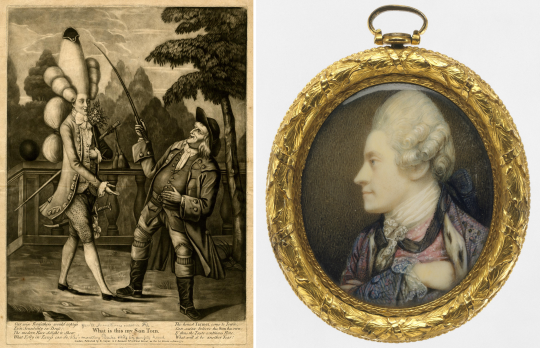
[Left: What is this my son Tom, print, c. 1774, published by Sayer & Bennett, via The British Museum.
Right: Self-Portrait, Ivory, c. 1770–75, by Richard Cosway, via The Met.]
The way Stede usually wears is hair is not particularly macaroni nor particularly 18th century for that matter. The exception to this is his wig from The Best Revenge Is Dressing Well though even this doesn’t have the iconic macaroni hight.

Interestingly both Stede and Ed are wearing flowers in their hair. While there are certainly depictions of women with flowers in there hair I’m not aware of this being a trend in mens fashion at all. However macaroni were known for wearing large nosegays.
While the tall hair was certainly iconic not all macaroni wore their hair tall. Joseph Banks, who was satirised as “The Fly Catching Macaroni” by Matthew Darly, is depicted in his portrait with a fairly typical 18th century hairstyle. Its not the hair alone that makes a macaroni, it was just one aspect of the fashion.
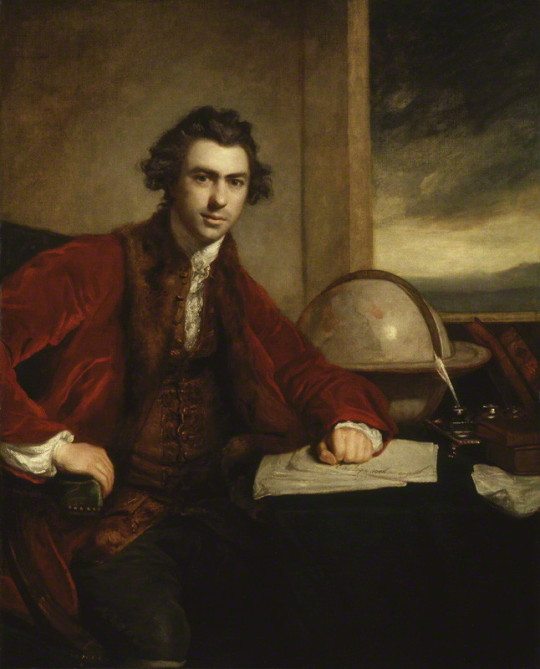
[Sir Joseph Banks, oil on canvas, c. 1771-1773, by Sir Joshua Reynolds, via Wikimedia.]
Suit
“If I went to Almack’s and decked out my wrinkles in pink and green like Lord Harrington, I might still be in vogue.” ~ Horace Walpole to Lord Hertford, 25 Nov 1764
Menswear of the period consisted of the same basic elements; shirt, stockings, breeches, waistcoat and coat. What differentiated the macaroni from others was the fabric, cut, colour and trimmings of the suit. “At a time when English dress generally consisted of more sober cuts and the use of monochrome broadcloth,” explains Peter McNeil “macaronism emphasised the effects associated with French, Spanish and Italian textiles and trimmings”. Popular amongst macaroni were brocaded and embroidered silks and velvets, sometimes further embellished with metallic sequins, simulated gemstones and raised metallic threads. Popular colours included pastels, pea-green, pink, red and deep orange. (McNeil, p30-32)
Far from wearing “monochrome broadcloth” Stede likes a “fine fabric” and dresses in a range of colours, we see him in teal, pink, purple, green, white, red, peach &c.
Tightly cut French style suits known as habit à la française were popular with macaroni. (McNeil, p14) Stede’s suits vary somewhat in cut but some are very French. The peach suit Stede wears in We Gull Way Back particularly has a very macaroni feel to me. Compare it to the English suit (left) and the French suit (right).

From the back you can see the English suit has more of a skirt to it.

Both Stede’s suit and the French suit are somewhat plain but have been paired with a floral embroidered waistcoat, while the English suit has a matching plain black waistcoat.
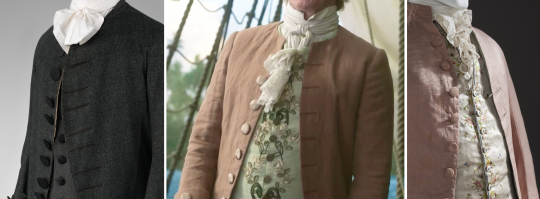
[Left: English suit, wool, silk, c. 1755–65, via The Met, number: 2009.300.916a, b.
Right: French suit, Silk plain weave (faille), c. 1785, via LACMA, number: M.2007.211.47a-b.]
Fabric covered button’s were common in the 18th century, you can see them on both the French and English coats above. In contrast Stede wears a lot of metal buttons. Steel buttons were popular amongst macaroni, a trend that was satirised in Steel Buttons/Coup de Bouton.

[Steel Buttons/Coup de Bouton, print, c. 1777, by William Humphrey, via The British Museum.]
Pumps and Parasols
“Maccaronies who trip in pumps and with Parasols over their heads” ~ Mrs Montagu
High heels had been popular amongst men during the 17th century. The Royal Collection Trust explains:
In the first half of the 17th century, high heeled shoes for men took the form of heeled riding or Cavalier boots as worn by Charles I. As the wearing of heels filtered into the lower ranks of society, the aristocracy responded by dramatically increasing the height of their shoes. High heels were impractical for undertaking manual labour or walking long distances, and therefore announced the privileged status of the wearer.
(Royal Collection Trust, High Heels Fit for a King)
In 17th century France Louis XIV popularised red-heels by turning them into a symbol of political privilege, which in turn spread the fashion to England. But with the sobering of menswear in England around the turn of the century the high heel and the red-heels went out of fashion. (see Bata Shoe Museum Toronto, Standing TALL: The Curious History of Men in Heels)
The high heel had a bit of a resurgence in the 1770s with macaroni fashion. The Natural History of a Macaroni snipes that the macaroni’s “natural hight is somewhat inferior to he ordinary size of men, through by the artificial hight of their heels, they in general reach that standard”. (Walker’s Hibernian Magazine, July 1777, p458)
Red-heels were reintroduced to England by young men returning from their Grand Tours. A young Charles James Fox (satirised by Mathew Darly as “the Original Macaroni”) wore such French style red-heeled shoes. The Monthly Magazine recalls a young Fox as a “celebrated “beau garçon” with “his chapeau bras, his red-heeled shoes, and his blue hair-powder.” (Oct 1806) and The Life of the Right Honorable, Charles James Fox recalls him in his “suit of Paris-cut velvet, most fancifully embroidered, and bedecked with a large bouquet; a head-dress cemented into every variety of shape; a little silk hat, curiously ornamented; and a pair of French shoes, with red-heels;” (p18) And in Recollections of the Life of the Late Right Honorable Charles James Fox B.C. Walpole recalls him as “one of the greatest beaus in England,” who “indulged in all the fashionable elegance of attire, and vied, in point of red heels and Paris-cut velvet with the most dashing young men of the age. Indeed there are many still living who recollect Beau Fox strutting up and down St. Jame’s-street, in a suit of French embroidery, a little silk hat, red-heeled shoes, and a bouquet nearly large enough for a may-pole.” (p24)
Compare the French style red-heeled shoes of Louis XIV to Stede’s red-heeled shoes.

[Left: detail of Louis XIV, oil on canvas, c. 1701, by Hyacinthe Rigaud, via Wikimedia.]
However most macaroni were depicted wearing the more standard late 18th century low-heeled bucked shoes. Where they distinguished themselves was the size and decoration of the buckles. “Such buckles could be set with pate (lead glass) or ‘Bristol stones’ (chips of quartz), or diamonds if you were very rich.” Explains peter McNeil, “The new macaroni fashion was for huge silver or plated Artois shoe buckles which the Mourning Post claimed weighed three to eleven ounces.” (p90)
While certainly not as iconic has his heels Stede also wears these sorts of shoes. Compare below the shoes from a macaroni caricature to Ed wearing Stede’s shoes (I couldn’t get a good shot of Stede wearing them).

[Left: detail of How d'ye like me, print, c. 1772, published by: Carington Bowles, via The British Museum.]
“A great many jewelled accessories accompanied the macaroni look”, writes Peter McNeil, “They included hanger swords, very long canes, clubs, spying glasses and snuff-boxes.” (p68) Tragically we don’t see Stede with a fashionable dress sword or a cane but we do see him with another accessory popular amongst macaroni; a parasol.
Popular in France parasols/umbrellas were adopted by the macaroni. They were popular amongst both men and woman in France but in England they had a feminine connotation. (McNeil, p129) In the 1780s as umbrellas became more popular amongst men there was a cultural pushback to the perceived gender transgression. On the 16th of August 1780 the Morning Post complains of of the “canopy of umbrellas” bemoaning that “the effeminacy of the men, inclines them to adopt this necessary appendage of female convenience”. On the the 4th Oct, 1784, the Morning Chronicle published a letter complaining of “that vile foppish practice of sheltering under a umbrella”. The author of this tirade writes that while “the ladies should be allowed to secure their beauty and persons from the heat of the sun, or the inclemency of the weather,” because “it is natural, and has a striking effect”, that “to see a great lubberly cit, bounce from his shop, with a coat, hat, and wig that are not together worth one groat,” sheltering “from the influence of the solar beam” was “intolerable.” However:
The macaroni being of the doubtful gender, may in part claim a feminine right; his dress is too delicate to bear an heavy shower, perhaps his person is so too; but a coach, if a clean one is to be found would serve his purpose much better, as there would be less likelihood of his being washed away into the kennel, which he deserves to be kicked into for his d-----d affectation.

Wealth
Born from rich young men returning from their tours with a taste for French and Italian textiles macaroni fashion was expensive. Certainly a working class man would not be able to afford Stede’s wardrobe. Both the sheer amount of clothes he has as well has the fabrics those clothes are made of are indications of wealth. However to say that Stede’s wardrobe is only an indication of wealth would be missing part of picture.
Most rich upper class English men (including colonial) wore plain monochrome suits. Even amongst the gentry macaroni fashion was not the norm. Compare bellow George Washington (left) who was a wealthy planation owner, but notably not a macaroni, to Richard Cosway (right) who was a famous macaroni.

[Left: George Washington, oil on canvas, c. 1796, by Gilbert Stuart, via Pennsylvania Academy of the Fine Arts.
Right: Detail of The Academicians of the Royal Academy, oil on canvas, c. 1771-72, by Johan Zoffany, via The Royal Collection Trust.]
In spite of the expense macaroni fashion was not exclusive to the upper classes. “Macaroni dress was not restricted to members of the aristocracy and gentry,” writes McNeil, “but included men of the artisan, artist, and upper servant classes, who wore versions of this visually lavish clothing with a distinctive cut and shorter jackets. Wealthier shopkeepers and entrepreneurs also sometimes wore such lavish clothing, particularly those associated with the luxury trades, such as mercers and upholsterers -” (p14)
It was possible to copy certain aspects of macaroni fashion on a cheeper budget. The hairstyle in particular was achievable without braking the bank. And there were ways to replicate the effects of certain expensive fashion trends for cheeper prices. For example patterns could be printed rather than embroidered.

[Left: printed waistcoat, cotton, c. 1770–90, via The Met, number: 35.142.
Right: embroidered waistcoat, silk, c. 1780–89, via The Met, number: 2009.300.2908.]
The Town and Country Magazine complains “we now have Macaronies of every denomination, from the colonel of the Train’s-Bands down to the errand-boy.” (McNeil, p169) The Morining Post mocks macaronies that couldn't financially keep up with the trends:
The macaronies of a certain class are under peculiar circumstances of distress, occasioned by the fashion, now so prevalent, of wearing enormous shoe-buckles; and we are well assured that the manufactory of plated ware was never known to be in so flourishing a situation.
(14 Jan, 1777)
In 18th century England, class was about more than just how much money you had. It was about pedigree. “English society was particularly alert to those whom it felt were using clothes to achieve a social status they did not merit” explains McNeil. Richard Cosway was a famous macaroni from modest background. Born to a Devonshire headmaster he was sent to London to study painting at 12. He became a very successful miniature painter and grew rich from the patronage of the Prince of Wales (later George IV) and Whig circles. In Nollekens and his Times J.T. Smith writes of Cosway:
He rose from one of the dirtiest boys, to one of the smartest of men. Indeed so ridiculously foppish did he become that Mat Darly, the famous caricature print-seller, introduced an etching of him in his window in the Strand, as ‘The Macaroni Miniature Painter’
(McNeil, p105-14)
But it was not only the Darlys that satirised Cosway Hannah Humphrey mocks Cosway as a social climber in A Smuggling Machine or a Convenient Cos(au)way for a Man in Miniature which depicts him standing under the petticoats of his much taller wife Maria. In the background there is a picture of Cosway climbing a ladder that rests upon a woman (she is believed to either be Angelica Kauffman or the Duchess of Devonshire). Below this reads:
Lowliness is Young Ambitions Ladder,
Whereto the climber upward turns his Face
But when he once attains the upmost round
He then unto the Ladder turns his back,
Looks unto the clouds - scornin [sic] the base degrees
By which he did assend.
Shak. Jul. Caesar.

[A Smuggling Machine or a Convenient Cos(au)way for a Man in Miniature, print, c. 1782, by Hannah Humphrey, via The British Museum.]
Another famous macaroni not born into the aristocracy was Julius Soubise. Brought to England from the West Indies as a slave he was taken in by Catherine Hyde, the Duchess of Queensbury. She gave him a leisured childhood, in which he was taught to play and compose for the violin, was taught to fence by Domenico Angelo, and learned oration from David Garrick. “Macaroni caricatures of Soubise parodied a foppish upstart whose outfits and entertainments, financed by the Duchess, affronted both racial and social expectations of an African male.” Writes Petter McNeil, Soubise was satirised as “a Mungo Macaroni” an “offensive term meaning a rude or forward black man.” (p118)
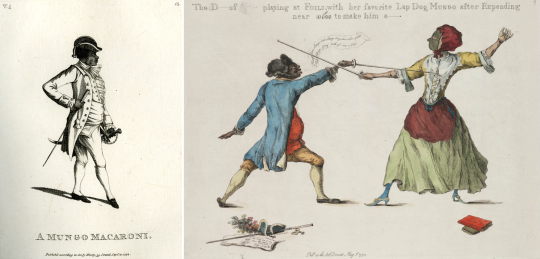
[Left: A Mungo Macaroni, print, c. 1772, by Matthew Darly, via The British Museum.
Right: The D------ of [...]-- playing at foils with her favorite lap dog Mungo after expending near £10000 to make him a----------*, print, c. 1773, by William Austin, via Yale Center for British Art.]
The expense of Stede’s wardrobe is a key part of the narrative. Stede has nice fancy luxurious things. Ed wants nice fancy luxurious things. Ed was born a poor brown boy and while he may be rich now he can never truly change his class. He could be as rich as Richard Cosway or Julius Soubise but to the gentry he will always be that poor brown boy.

Gender
As we have already seen in the tirade against men using umbrellas the macaroni was perceived as being of “the doubtful gender”. (The Morning Chronicle, 4 Oct, 1784)
The Natural History of a Macaroni writes that there “has within these few years past arrived from France and Italy a very strange animal, of the doubtful gender, in shape somewhat between a man and monkey,” that dresses “neither in the habit of a man or woman, but peculiar to itself”. The author states that “they are in no respect useful in this country”:
that the minister of the war department would give orders to have them enlisted for the service of America: we do not mean to put them on actual duty there. Alas! they are as harmless in the field, as they are in the chamber, but they may stand as faggots to cover the loss of real men.
(Walker’s Hibernian Magazine, July 1777, p458-9)
A “faggot” being “A man who is temporarily hired as a dummy soldier to make up the required number at a muster of troops, or on the roll of a company or regiment.” (see OED)

[The Masculine Gender & The Feminine Gender, etching with touches of watercolour, c. 1787, Attributed to Henry Kingsbury, via The Met.]
The macaroni wasn’t just considered effeminate because of the way they dressed but also because of their interests and the way walked and talked. Famous for playing fops and macaroni, the actor David Garrick did a lot to establish the character of the macaroni in the public mind. In his poem The Fribbleriad Garrick mocks the men who were offended by his performances asserting, perhaps accurately, that they were offended because it was them he mocked. He portrays a group of angry effeminate men meeting in order to seek revenge on him for his portrayal of them:
May we no more such misery know!
Since Garrick made OUR SEX a shew;
And gave us up to such rude laughter,
That few, ’twas said, could hold their water:
For He, that player, so mock’d our motions,
Our dress, amusements, fancies, notions,
So lisp’d our words, and minc’d our steps,
The macaroni had become more than simply an effeminate man, he had become a new sex. Something not quite man or woman. Something in-between. A new description of a macaroni asks the question:
Is it a man? ‘Tis hard to say - A woman then
- A moment pray -
So doubtful is the thing, that no man
Can say if ‘tis a man or woman:
Unknown as yet by sex or feature,
It moves - a mere amphibious creature.
(McNeil p169)
Sexuality
Much like today in the 18th century effeminacy was associated with homosexuality. Men who had sex with other men were known as mollies. A Classical Dictionary of the Vulgar Tongue (1785), defined a molly as “A Miss Molly; an effeminate fellow, a sodomite”. In the History of the London Clubs (1709), Ned Ward characterises mollies as follows:
There are a particular Gang of Wretches in Town, who call themselves Mollies, & are so far degenerated from all Masculine Deportment or Manly exercises that they rather fancy themselves Women, imitating all the little Vanities that Custom has reconcil’d to the Female sex, affecting to speak, walk, tattle, curtsy, cry, scold, & mimick all manner of Effeminacy.
“By the 1760′s,” explains Peter McNeil, “too much attention to fashion on the part of a man was read as evidence if a lack of interest in women”. (p152)
Macaroni were often portrayed as incapable or simply uninterested in sexual relations with women. This attitude is expressed by Mr. Bate in the following dialogue from The Vauxhall Affray; Or, the Macaronies Defeated:
Mr. Fitz-Gerall: I always though a fine woman was only made to be looked at.
Mr. Bate: Just sentiments of a macaroni. You judge of the fair sex as you do your own doubtful gender, which aims only to be looked at and admired.
Mr. Fitz-Gerall: I have as great a love for a fine woman as any man.
Mr. Bate: Psha! Lepus tute es et pulpamentum quæris?
Mr. Fitz-Gerall: What do you say, Parson?
Mr. Bate: I cry you mercy, Sir, I am talking Heathen Greek to you; in plain English I say, A macaroni you, and love a woman?
Mr. Fitz-Gerall: I love the ladies, for the ladies love me.
Mr Bate: Yes, as their panteen, their play-thing, their harmless bauble, to treat as you do them, merely to look at
While lack on interest in woman does not necessarily mean attraction to men, Matthew Darly takes the implication there in his 1771 set of macaroni caricatures which induces a print entitled Ganymede, a reference to Zeus’ male lover of the same name. Ganymede is believed to be a parody of Samuel Drybutter who had been arrested for attempted sodomy in January 1770. Darly also includes the character Ganymede in Ganymede & Jack-Catch. Jack-Catch is a reference to the infamous English executioner John Ketch. In the print Jack-Catch says, “Dammee Sammy you’r a sweat pretty creature & I long to have you at the end of my String.” Ganymede replies, “You don’t love me Jacky”. Jack-Catch is holding a noose with one hand and stroking Ganymede’s chin with the other. Jack-Catch is soberly dressed in typical 18th century menswear, while Ganymede’s dress is distinguished by his lace ruffles and styled wig. The print is not only suggesting that macaroni are sodomites but making a joke of the execution of them. The punishment for a sodomy at this time in England being death by hanging.

[Left: Ganymede, print, c. 1771, Matthew Darly, via The Met.
Right: Ganymede & Jack Catch, print, c. 1771, Matthew Darly, via The British Museum]
An anonymous letter to the Public Ledger (5 Aug, 1772) says blatantly what others had already implied. “The country is over-run with Catamites, with monsters of Captain Jones’s taste, or, to speak in a language witch all may understand, with MACCARONIES”. The writer warns macaroni who have “escaped detection” as sodomites and “therefore cannot fairly be charged” that they have not avoided suspicion:
Suspicion is got abroad-the carriage-the deportment-the dress-the effeminate squeak of the voice-the familiar loll upon each others shoulders-the gripe of the hand-the grinning in each others faces, to shew the whiteness of the teeth-in short, the manner altogether, and the figure so different from that of Manhood, these things conspire to create suspicion; Suspicion gives birth to watchful observation; and, from a strict observance of the Maccaroni Tribe, we very naturally conclude that to them we are indebted for the frequency of a crime which Modesty forbids me to name. Take warning, therefore, ye smirking group of Tiddy-dols: However secret you may be in your amours, yet in the end you cannot escape detection;
Bows on His Shoes
18th century shoes were typically buckled, laces and ribbons were simply unfashionable. As mentioned previously macaroni were distinguished by the size and decoration of the buckles. So are Stede’s bows simply ahistorical? Well there are references to 18th century men wearing laces and ribbons.
Towards the end of the 18th century laces started to come into fashion. Appeal from the Buckle Trade of London and Westminster, to the Royal Conductors of Fashion (1792) complained that despite how “tender and effeminate the appearance of Shoe Strings” the “custom of wearing them has prevailed.”
Perhaps the most intriguing reference is that of Commissioner Pierre Louis Foucault’s papers where he details the surveillance, investigation and entrapment of "pederasts” in Paris. It is important to note that the word “pederasty” was used synonymously with “sodomy” in the 18th century and did not denote age simply sex. An Universal Etymological English Dictionary (1726) defines “A pederast” as “a Buggerer” and “Pederasty” as “Buggery”.
Foucault and the men working with him identified particular clothing worn by men seeking sex with other men that he called the “pederastical uniform”. In Foucault’s papers men are described as being “attired in such a way as to be recognized by everyone as a pederast”, “clothed with all the distinctive marks of pederasty”, or simply “dressed like a pederast”. This “uniform” generally included “some combination of frock coat, large tie, round hat, small chignon, and bows on the shoes.” Jeffrey Merrick in his article on Foucault speculates that these men dressed this way to signal to each other. However when questioned by police they would understandably deny such a purpose, one man when questioned about his outfit responded that everyone “dresses as he sees fit”. (Jeffrey Merrick, Commissioner Foucault, Inspector Noël, and the “Pederasts” of Paris,1780-3)
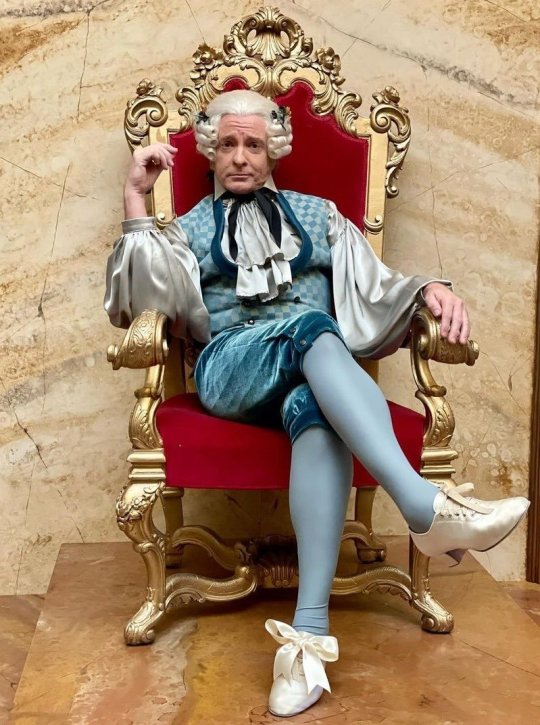
Conclusion
I’m not saying Stede is intended to be a macaroni. If that were the case they would have given him the iconic macaroni hairstyle. However the costuming team has clearly pulled from fashion trends that were associated with effeminacy and homosexuality. While OFMD is evidently wholly unconcerned with creating period accurate costumes the costumes are still clearly inspired by historical fashions. Perhaps the curtains really are just blue but maybe Stede wears bows on his shoes because he’s gay.
#I had way too much fun doing this#our flag means death#ofmd meta#stede bonnet#queer history#macaroni#historical fiction#fashion history
196 notes
·
View notes
Text
Evan Ramsey: 1997 Bethel Regional High School
Summary of the 1997 Bethel Regional High School shooting committed by Evan Ramsey. Note: this is for informational, educational purposes only. Post is below the cut.

Background:
Evan Ramsey was born on February 8th, 1981, in Anchorage, Alaska to Don and Carol Ramsey. When Evan was five years old, his father was arrested and sentenced to 10 years in prison for attempted kidnapping, aggravated assault, and reckless endangerment at the Anchorage Times building. The incident occurred after Don Ramsey’s attempts to speak with government officials about his family’s poor living conditions were unsuccessful. This failure led Don on a campaign to slander government officials in hopes that they would be removed from office. One part of this campaign included a full-page advertisement against Senator Frank Murkowski, which was paid for by Don. The advertisement only ran for a short period of time before being redacted from future publications. On October 21st, 1986, Don Ramsey entered the Anchorage Times building with guns, grenades, and other hand weapons with the intent of killing Robert Atwood, the publisher he deemed responsible for the removal of his advertisement and a fire that caused extensive damage to the Ramsey’s apartment a few months prior. He was subdued by employees in the building and arrested.
After her husband’s arrest, Evan’s mother spiraled into a severe case of alcoholism and began dating abusive men. As a result of neglect, Evan and his brothers were placed in the foster care system. The Ramsey brothers lived in ten foster homes in the span of two years, many of which ranged from unsuitable to violent. In one of these foster homes, Evan and his brother faced severe physical abuse from their foster parents. The biological son of these parents would also torture Evan and his brother; being attacked, urinated on, and sexually abused were common occurrences. After a school nurse noticed signs of physical abuse on Evan and his brother, the Department of Youth and Family Services was notified, and the boys were relocated to the home of Sue Hare. Evan described Sue as a positive role model for him. When he told her about the bullying he faced at school, she encouraged him to report the instances of bullying and to not retaliate. However, his problems in school persisted.
“Well I can tell you that the Superintenant Sue Hare has been the nicest person I’ve ever met cause she took both William and I in and didn’t get any money for it, and she like was a mother for William and me.“ - excerpt from Evan Ramsey’s suicide note written shortly before the shooting (1997)
Evan had been dealing with depression as early as the age of 10, and even attempted suicide (possibly multiple times) between the ages of 10-16.
School Life:
Along with his ever-changing and abusive home life, Evan claimed to be frequently teased and bullied at school. He has stated that this was likely due to him being mixed– he was targeted by both white and Indigenous students, and he did not feel accepted by either group. Students nicknamed him Screech after a character from the television show Saved by the Bell. Former friends of Evan described him, along with the rest of their friend group, as outsiders. Despite being a target for physical and verbal bullying, Evan was described as an empathic and funny friend.
Around two weeks before the shooting, students at Bethel Regional High School had heard of Evan’s plans to bring a gun to school. Reports claim that at least 15 people knew of his plans. In fact, some students encouraged these plans and helped him. Two of Evan’s friends, James Randall and Matthew Charles, helped Evan organize a “hitlist” of people who had bullied him. James also taught the inexperienced Ramsey how to load and shoot a gun. Instead of taking the threat seriously and reporting it, students planned to bring cameras to school to record the event.
Shooting:
On February 19th, 1997, Evan Ramsey concealed a Mossberg 12-gauge shotgun in his pants and walked to his normal bus stop. He made small talk with others while waiting for the bus. After arriving at Bethel Regional High School, Evan entered the commons area and shot three students. Although the other two students survived their injuries, Fifteen-year-old Josh Palacios, who was shot in the abdomen, succumbed to his injuries shortly after. Art teacher Reyne Athanas and another teacher pleaded with Evan to stop three times. Instead of surrendering, Evan continued the shooting in the main lobby, where he fatally shot principal Ron Edwards twice. He returned to the commons with the intention of killing himself. After shooting one round at nearby police, he positioned the shotgun under his chin. However, Evan did not shoot. He abruptly decided to not kill himself and was quoted saying “I don't want to die” as he placed the gun on the ground and surrendered.
“I don’t know who came to the school that day, but it wasn’t my friend. It wasn’t Evan, and I think whoever that person was that came must have killed him too.” - a friend of Evan Ramsey, interviewed for “Bethel, 20 Years Later”
Evan wrote two notes prior to the shooting:
“I have thought to myself, what kind of damage can a 12 gauge slug do to a human’s internal organs or their head? Well today I found out, and so did everyone else that is in school . . . No, I am not on drugs . . . ciggerettes, that’s all. I am not really depressed just that the fact that I want people, the world, or maybe just Bethel, to know how [expletive] and cruel the world is or can be. This school has got to get its [expletive] together ’cause there are too many deaths this past 2–3 years. Well I can tell you that the Superintenant Sue Hare has been the nicest person I’ve ever met cause she took both William and I in and didn’t get any money for it, and she like was a mother for William and me. But anyway I’m dead you guys are living, you should be happy.“
“Hey Every body!! I feel rejected, rejected, not so much alone, but rejected. I feel this way because the day-to-day treatment I get usually it’s positive but the negative is like a cut, it doesn’t go away really fast. I figure by the time you guys are reading this I’ll probably have done what I told EVERYONE I was going to do. Just hope 12 gauges don’t kick too hard but I do hope the shells hit more than 1 person because I am angry at more than 1 person. One of the Big [expletive] is Mr. Ron Edwards, he should be there, I was told this will be his Last year, but I know it WILL BE HIS LAST YEAR. The main reason that I did this is because I’m sick and tired of being treated this way everyday . . . By the way every one allways told me “Don’t Judge A Book By It’s Cover.’’ This saying is true because I was told that my teachers say that “He’s Such A Good Kid.’’ But they Say that About everyone. I don’t think I’m a good-Hearted person. LIFE SUCKS in its own way, so I killed a little and killed myself. Jail isn’t and wasn’t for me, ever”
Trial:
During the trial, the defense argued that Evan’s understanding of guns and murder were based on video games such as Doom. Specifically, he was under the impression that people could not die from a single gunshot wound. Because of this, the defense claimed he could not have foreseen or understood the effects of his actions. It was also argued that Evan was suicidal and never intended on killing anyone but himself, but one of the notes he wrote prior to the shooting implied otherwise. The letter also implied that Ron Edwards was a main target, leading to first-degree murder charges. The defense wanted to use Evan’s history of abuse in the foster care system as evidence, but this was opposed.
On December 2nd, 1998, Evan Ramsey was found guilty on two counts of first-degree murder, one count of attempted murder, and fifteen counts of second-degree assault. He was originally sentenced to 210 years, but this sentence was later changed to two 99-year sentences with the possibility of parole in 2066. James Randall and Matthew Charles were charged and sentenced as juveniles for their involvement in the shooting, but both have since been released.
Appeals and Recent News:
In 2002, Evan Ramsey attempted to appeal his case. The primary reason for the appeal was because Evan’s defense was not allowed to introduce past physical and sexual abuse as evidence. However, this appeal was denied.
In 2005, Evan Ramsey appealed his sentence, which led to the sentencing of 2 99-year sentences with the possibility of parole in 2066.
Although apathetic during the shooting and trial, Evan’s mindset towards the event has since changed. He stated in an interview that the death of his mother gave him perspective as to how drastically his actions changed the lives of others. He has stopped trying to appeal his sentence, as he realized it would only cause more pain to the families affected.
"I would tell them the situation they're in now is not half as bad as the situation they're going to be in if they do something similar to what I did. It will only get worse." - Evan Ramsey, when asked what he would tell potential school shooters (2001)
47 notes
·
View notes
Text



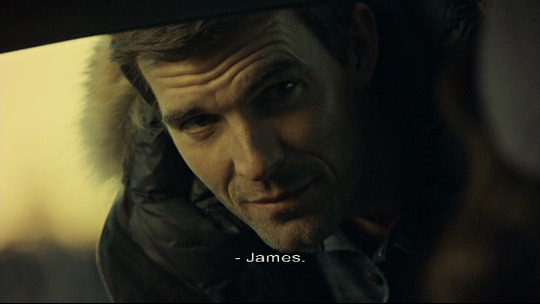
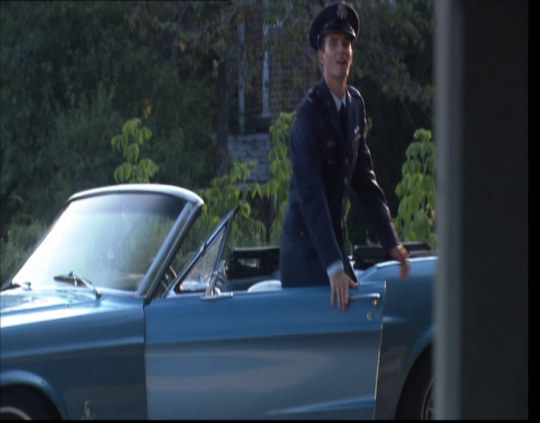




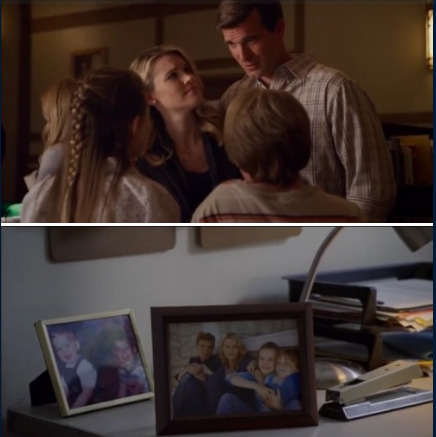

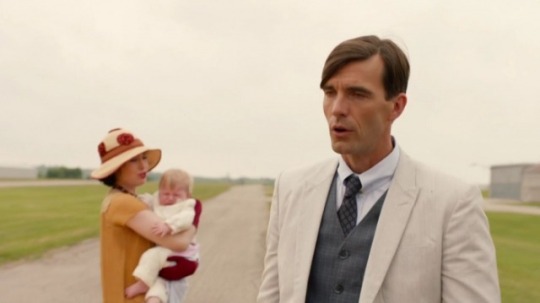
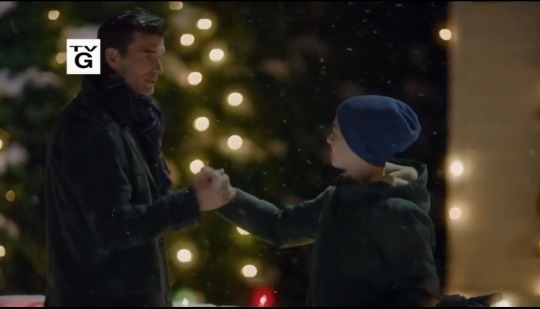


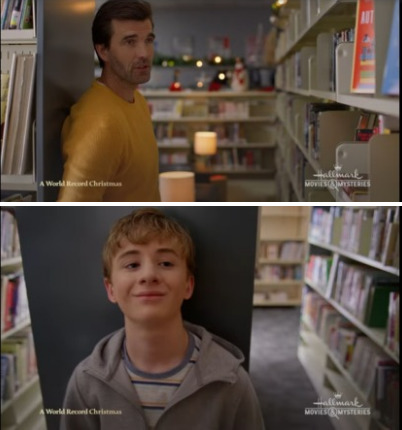

Lucas Bryant as (Step)Dad (2004-2023) [for Finnish Father's Day 2023]
1. Nathan Wuornos (Haven 3x13 Thanks for the Memories/ 5x26 Forever, 2013/2015)
2. Young Chuck Taggart (Odyssey 5 1x14 Begotten, 2004)
3. Calvin Puddie (Playing House, 2006)
4. Harry (Faux Baby webseries 1x5 Super Dad, 2008)
5. Peter Claus (Merry In-Laws, 2012)
6. Jesse Powell (Cracked 1x12 Old Soldiers, 2012)
7. Daniel Kenman (Secret Summer, 2016)
8. Colin Fitzgerald (Summer Love, 2016)
9. Phillip Anderson (Frankie Drake Mysteries 1x8 Pilot, 2018)
10. Jack Sutherland (Time for You to Come Home for Christmas, 2019)
11. Matthew Anderson (The Angel Tree, 2020)
12. Matthew Jamison (Five More Minutes: Moments Like These, 2022)
13. Eric Parsons (A World Record Christmas, 2023)
1. Biological father of James Cogan (Steve Lund), 20 years before he was born. Gets to raise him after the finale from a baby.
2. Young version of Chuck Taggart, father to Neil and Keith.
3. Expectant father, briefly co-parent, ends up with the mother (Joanne Kelly).
4. His wife (Missy Yager) gets a practice doll when they are thinking of getting kids.
5. Son of Santa, a teacher, wants to marry an astrologist (Kassia Warshawski) with a son who is in his class. Jacob Thurmeier as Max Spencer.
6. Homeless army vet suffering from PTSD makes some attempts to be a better father to his son raised by his brother.
7. Father and husband with two kids works a lot, so he has his brother take care of the kids during a summer. Max Page as Noah and Chiara Aurelia as Hailey. Emily Rose as wife.
8. Maya (Rachel Leigh Cook) works an internship at his tech company over the summer, they fall in love. Maya's daughter approves as they go sail around. Hannah Cheramy as Addison Sulliway
9. 1920s Canadian pilot and eugenics enthusiast. Has a deaf son he tries to get kidnapped and killed. He dies instead.
10. Meets a widow (Alison Sweeney) and her son on the way to figure out who saved his life years prior. Turns out it was the widow's late husband. He falls in love and gets along well with the son. In Time for Them to Come Home for Christmas (2021), Alison Sweeney's character reveals they got married. Kiefer O'Reilly as Will Moss.
11. Reunites with childhood best friend (Jill Wagner) who has a daughter and a dead husband. Also raising his nephew while his sister Zoe (Clare Filipow) is stationed over seas. Cassidy Nugent as Cassie McBride and Oscar Farrell as Owen Anderson.
12. Played football with the widow's (Ashley Williams) husband in high school, now works as a real estate person wanting to buy the house they lived in. Helps renovate the house and they fall in love while he also develops a relationship with the son. A funcle to 8 nephews. Brady Droulis as Adam Morrison.
13. Stepfather to an autistic kid. Bio dad left. Becomes Dad to Charlie and has another baby with his wife (Nikki DeLoach) in the end. Aias Dalman as Charlie Parsons.
#lucas bryant#lucasbryantedit#haven cast#havensyfy#nocticola art#nathan wuornos#odyssey 5#calvin puddie#playing house 2006#harry (faux baby)#merry in laws#peter claus#jesse powell#cracked cbc#secret summer 2016#summer love 2016#frankie drake mysteries#1x8 pilot#time for you to come home for christmas#jack sutherland#matthew anderson#philip anderson#matthew jamison#the angel tree#five more minutes moments like these#a world record christmas#james cogan#steve lund#eric parsons
17 notes
·
View notes
Text
Ages of English Princesses at First Marriage
I have only included women whose birth dates and dates of marriage are known within at least 1-2 years, therefore, this is not a comprehensive list. The average age at first marriage among these women was 16.
This list is composed of princesses of England when it was a sovereign state, prior to the Acts of Union in 1707.
Eadgyth (Edith) of England, daughter of Edward the Elder: age 20 when she married Otto the Great, Holy Roman Emperor in 930 CE
Godgifu (Goda) of England, daughter of Æthelred the Unready: age 20 when she married Drogo of Mantes in 1024 CE
Empress Matilda, daughter of Henry I: age 12 when she married Henry, Holy Roman Emperor, in 1114 CE
Marie I, Countess of Boulogne, daughter of Stephen of Blois: age 24 when she was abducted from her abbey by Matthew of Alsace and forced to marry him, in 1136 CE
Matilda of England, daughter of Henry II: age 12 when she married Henry the Lion in 1168 CE
Eleanor of England, daughter of Henry II: age 9 when she married Alfonso VIII of Castile in 1170 CE
Joan of England, daughter of Henry II: age 12 when she married William II of Sicily in 1177 CE
Joan of England, daughter of John Lackland: age 11 when she married Alexander II of Scotland in 1221 CE
Isabella of England, daughter of John Lackland: age 21 when she married Frederick II, Holy Roman Emperor, in 1235 CE
Eleanor of England, daughter of John Lackland: age 9 when she married William Marshal, Earl of Pembroke in 1224 CE
Margaret of England, daughter of Henry III: age 11 when she married Alexander III of Scotland in 1251 CE
Beatrice of England, daughter of Henry III: age 17 when she married John II, Duke of Brittany in 1260 CE
Eleanor of England, daughter of Edward I: age 24 when she married Henry III, Count of Bar in 1293 CE
Joan of Acre, daughter of Edward I: age 18 when she married Gilbert de Clare, Earl of Gloucester in 1290 CE
Margaret of England, daughter of Edward I: age 15 when she married John II, Duke of Brabant in 1290 CE
Elizabeth of Rhuddlan, daughter of Edward I: age 15 when she married John I, Count of Holland in 1297 CE
Eleanor of Woodstock, daughter of Edward II: age 14 when she married Reginald II, Duke of Guelders in 1332 CE
Joan of the Tower, daughter of Edward II: age 7 when she married David II of Scotland in 1328 CE
Isabella of England, daughter of Edward III: age 33 when she married Enguerrand VII, Lord of Coucy in 1365 CE
Mary of Waltham, daughter of Edward III: age 16 when she married John IV, Duke of Brittany in 1361 CE
Margaret of Windsor, daughter of Edward III: age 13 when she married John Hastings, Earl of Pembroke in 1361 CE
Blanche of England, daughter of Henry IV: age 10 when she married Louis III, Elector Palatine in 1402 CE
Philippa of England, daughter of Henry IV: age 12 when she married Eric of Pomerania in 1406 CE
Elizabeth of York, daughter of Edward IV: age 20 when she married Henry VII in 1486 CE
Cecily of York, daughter of Edward IV: age 16 when she married Ralph Scrope in 1485 CE
Anne of York, daughter of Edward IV: age 19 when she married Thomas Howard in 1494 CE
Catherine of York, daughter of Edward IV: age 16 when she married William Courtenay, Earl of Devon in 1495 CE
Margaret Tudor, daughter of Henry VII: age 14 when she married James IV of Scotland in 1503 CE
Mary Tudor, daughter of Henry VII: age 18 when she married Louis XII of France in 1514 CE
Mary I, daughter of Henry VIII: age 38 when she married Philip II of Spain in 1554 CE
Elizabeth Stuart, daughter of James VI & I: age 17 when she married Frederick V, Elector Palatine in 1613 CE
Mary Stuart, daughter of Charles I: age 10 when she married William II, Prince of Orange in 1641 CE
Henrietta Stuart, daughter of Charles I: age 17 when she married Philippe II, Duke of Orleans in 1661 CE
Mary II of England, daughter of James II: age 15 when she married William III of Orange in 1677 CE
Anne, Queen of Great Britain, daughter of James II: age 18 when she married George of Denmark in 1683 CE
27 notes
·
View notes
Photo

Nancy Lawson was a free Black Bostonian woman who lived through the decades leading up to the American Civil War. While originally from Maine, she moved to Massachusetts and married a clothing merchant. The couple were connected to the Millerite, a religious movement led by Reverend William Miller, a Baptist minister who predicted the end of the world in 1844. While an eccentric, many of his followers, quiet possibly the Lawsons among them, made up the ranks of abolitionists and the Millerites advocated equality across races and genders.
This portrait was painted by Maine artist William Matthew Prior in 1843.
#history#black history month#for my afrofolio of period dramas#nancy lawson#our history is your history
146 notes
·
View notes
Text

TORONTO, ONTARIO - FEBRUARY 03: (L-R) Auston Matthews #34, Mitchell Marner #16, Morgan Rielly #44 and William Nylander #88 of the Toronto Maple Leafs pose for a photo during warm ups prior to the 2024 Honda NHL All-Star Game on February 03, 2024 in Toronto, Ontario. (Photo by Bruce Bennett/Getty Images)
8 notes
·
View notes
Photo
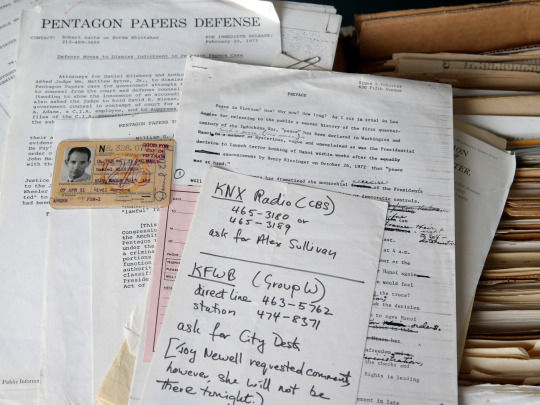
Daniel Ellsberg, who has died aged 92, was the most important whistleblower of our times. His 1971 leaking of what became known as the Pentagon Papers showed conclusively that virtually everything the American public had been told by its leaders about the Vietnam war, from its origins to its current conduct, was false.
The leak itself did not end the war, and Ellsberg regretted not having come forward years earlier. He spent the rest of his life as a peace activist, encouraging others on the inside to reveal government malfeasance, and supporting those who did, including the 2003 GCHQ whistleblower Katharine Gun. But his leaks did result in a landmark decision in favour of freedom of the press, and, ironically, led to the downfall of the US president Richard Nixon. It is not unreasonable to set Ellsberg’s leak alongside President John F Kennedy’s assassination as the ground zero of today’s distrust of politics.
Before working on the Pentagon Papers, officially a study titled A History of Decision-Making in Vietnam 1945-68 commissioned from the Rand Corporation research organisation by the secretary of defense Robert McNamara, Ellsberg had spent two years at the US embassy in Saigon, advising on General Edward Lansdale’s “pacification” programme. As he sifted through the material gathered for the report, including evaluations which deemed the war unwinnable, he realised the enormity of the political fraud.
He began copying the documents, with the help of a former Rand colleague Anthony Russo, and in 1971, as the US extended the war with bombings of Laos and Cambodia, resolved to make them public. The chair of the senate foreign relations committee, William Fulbright, turned him down, as did the Washington Post’s editor Ben Bradlee and owner Katharine Graham; Graham was close to the secretary of state Henry Kissinger, who had known Ellsberg at Harvard; he advised her Ellsberg was “unbalanced and emotionally unstable”. Matthew Rhys played Ellsberg in the 2017 film The Post which loosely covers those events.
Neil Sheehan of the New York Times was a reporter Ellsberg admired in Vietnam; Sheehan convinced the Times to take the papers, the first instalment of which revealed that the Gulf of Tonkin incident, the casus belli which launched full-scale US participation in the conflict, had been bogus.
The Nixon administration obtained an injunction prohibiting further publication; the supreme court’s overturning of that injunction, dismissing the idea of “prior restraint”, remains a cornerstone of US journalistic freedom. But leakers themselves were not protected. Ellsberg was hidden by anti-war activists while Mike Gravel, the US senator from Alaska, entered most of the leaked papers into the congressional record, and the Post played catch-up.
Meanwhile Nixon, furious at the leaks, created the so-called “plumbers” covert special investigation unit, to discover if Ellsberg had further material that might affect him directly, and to discredit him. When the plumbers’ bungled break-in at the Watergate offices revealed an earlier burglary of Ellsberg’s psychiatrist’s office, the ensuing chain of scandal and cover-up eventually forced Nixon’s resignation to avoid impeachment.
Ellsberg grew up the very definition of a true believer in America. Both his father, Harry, a structural engineer, and mother, Adele (nee Charsky), were the children of Russian Jewish immigrants, but had converted to Christian Science. When Daniel, born in Chicago, was six, his father found work in Detroit, building Ford’s massive Willow Run factory.
Daniel won a scholarship to the elite Cranbrook school in the Detroit suburbs; a talented pianist, he practised for four to six hours a day to fulfil his mother’s dream. But in 1946, rushing to Denver for a family gathering, his father fell asleep while driving and rammed into a bridge. His mother and younger sister, Gloria, both died; Daniel recovered from his severe injuries, but ceased playing the piano.
He won a scholarship to Harvard, where he studied economics, edited the college paper, and finished third in his class. Upon graduation he married a Radcliffe student, Carol Cummings, whose father was a colonel in the Marine Corps, and took up a Wilson fellowship for a year’s study at King’s College, Cambridge. In 1954, accepted as a Harvard junior fellow to pursue his doctorate, he instead joined the Marines, becoming a rare first lieutenant given command of a full company.
He returned to Harvard in 1957. His dissertation, Risk, Ambiguity and Decision, contained what is now known as the Ellsberg paradox, which delineated how the preference for well-defined probabilities, over the uncertainty of ambiguity, influences decision-making, especially as it reinforces preconceived ideas. It became an important part of game theory, and Ellsberg went to work for Rand on the Department of Defense’s Command and Control research, much of which was devoted to spit-balling Fail Safe/Dr Strangelove scenarios, as detailed in his 2017 book The Doomsday Machine: Confessions of a Nuclear War Planner.
In 1964 he went to the Department of Defense, as special assistant for international security to McNamara’s number two, John McNaughton, before moving to the State Department and Vietnam. In 1967 he rejoined Rand to work on McNamara’s project, but was increasingly tormented by Kissinger and Nixon’s Vietnam policy; they believed that if the US opened relations with China and entered into a detente with Russia, those countries would pressure North Vietnam to come to the table while the US bombed incessantly.
Ellsberg began joining anti-war campaigners, including the poet Gary Snyder, and was inspired by Randy Kehler, a draft-resister who spoke of welcoming imprisonment for his belief. Ellsberg left Washington for MIT’s Centre for International Studies a year before leaking the papers. His first marriage had ended in divorce; in 1970 he married Patricia Marx, a peace activist.
In June 1971, he surrendered himself to the US attorney in Boston; asked on the courthouse steps how he felt about going to prison, Ellsberg replied: “Wouldn’t you go to prison to end this war?” He became the first civilian charged with violating the 1917 Espionage Act, and faced a maximum sentence of 115 years. The District Court judge William Byrne ruled irrelevant his public-interest defence, that the documents were “illegally classified”, and so it has been for every whistleblower since. But Byrne eventually dismissed the case because of government malfeasance, including the plumbers’ break-ins, as well as Nixon’s wiretapping of Kissinger’s aide Morton Halperin, and John Ehrlichman’s offering Byrne the directorship of the FBI.
In 1974, Ellsberg’s moving interviews were a major part of the Oscar-winning Vietnam documentary Hearts and Minds. In 1978 he was awarded the Gandhi prize by Promoting Enduring Peace. In the next 40 years he was arrested around 50 times at anti-war protests. He likened the weapons of mass destruction excuse for invading Iraq in 2003 to the Gulf of Tonkin affair, and over the years supported leakers who revealed government deceptions, including Edward Snowden, Chelsea Manning and Reality Winner, who was sentenced to five years in prison for leaking a single page from an in-house National Security Agency magazine showing the NSA had concluded Russia interfered in US elections, while the government was maintaining they had not.
He recognised a practical corollary to the Ellsberg paradox: the more secrets you are able to access, the less able you become to act sensibly with them. In 2021, Ellsberg released government memos from 1958, showing that the joint chiefs of staff had prepared a nuclear first-strike against Chinese bases on Quemoy and Matsu during the Taiwan Strait crisis, with a full nuclear attack planned on China should they respond. His point was that little had changed since the Pentagon Papers.
Ellsberg was played by James Spader in the 2003 film The Pentagon Papers, and was the subject of a 2009 documentary, The Most Dangerous Man in America. His memoir, Secrets, appeared in 2003 and in 2021 Risk Ambiguity and Decision was updated as a book, once again challenging the concept of rational decision.
Ellsberg is survived by his wife and their son, Michael, and his son, Robert, and daughter, Mary, from his first marriage.
Daniel Ellsberg, military analyst and political activist, born 7 April 1931; died 16 June 2023
Daily inspiration. Discover more photos at http://justforbooks.tumblr.com
22 notes
·
View notes
Note
Ooooo what are your headcanons about Alfred's insecurities!? 8)
oops! i get really infodumpy. there's Migraines in Margaritaville context at the beginning and headcanons for this AU's Alfred's insecurities alllll the way at the end. if you just want to skip to it there's be a header in pink that says Woe, Insecurities Be Upon Alfred. anything that i talk about in the context section is stuff I've already talked about in the prologue and first chapter of the fic, found here, or information that isn't relevant enough to be mentioned in the fic and is more fun fact
okay so I came up with a really funny way to refer to Migraines in Margaritaville whenever I'm mentioning that fic casually
I will now refer to anything regarding that fic as The Margaritaverse
Anyway, to give a quick recap on Margaritaverse Alfred and Matthew:
Alfred (Kirkland-Bonnefoy) F. Jones is a popular Youtuber living just outside of New York City. His channel is all about food. You could consider him a food critic, but he also tries strange vintage recipes, debunks Tiktok recipes, and explores the cookbook left to him by his Papa when he and Alfred's dad moved back to Europe (The prologue actually starts off with him cooking a cake from his childhood that will be relevant later). He lives alone and doesn't have many friends aside from his old college roommate and Kiku Honda, a fellow popular food Youtuber (and full time surface design illustrator) who he met at Vidcon the year prior. His entire life right now is making content for Youtube because even though he's got a double degree in finance and marketing, he can't manage to find a job in his field
Matthew (Kirkland-Bonnefoy) Williams is a hockey star who moved to Montreal, Quebec immediately after college. Fun fact, he actually lives in Kirkland, which is a suburb of Montreal (I literally only chose it because of the name). He's been playing hockey practically his whole life and spends as much time outdoors as possible. He's doing really well for himself; He's got a lovely Samoyed dog named Kumajirou, a house (in this economy???), and his girlfriend of three years, Kateryna (I'm still not set on a last name for her, but I've been using Chernenko because that's what I've seen floating around. I'm up to suggestions!)
Alfred and Matthew are identical twins who grew up in Massachusetts. Never been quite set on how the boys came to be other than being born in 1998, so whether they're fully adopted or related to just one of their dads is up in the air. Regardless, they grew up unable being to escape being compared at home, at school, and anywhere really.
Alfred's insecurities stem from Matthew receiving a lot of attention from their dads. I thought it'd be fun to play with the idea that Alfred was accidentally ignored rather than Mattie and see what That Does To Him. Alfred's not a quiet kid -- he kinda just has a hard time fitting in. Not gonna lie, he probably has the Neurodivergent Kid Experience of being isolated from your peers for being "different." We see this in Chapter One of MIM when Alfred is excluded from a birthday party by their peers when Matthew is invited and he doesn't really fit in with the group his brother hangs around (Mattie tries to include him, to limited success). When Matthew picks up hockey, everything suddenly becomes about Matthew because he needs to be driven to practice, he needs equipment, oh no! he got hurt, and he also turns out to be pretty dang good at this thing.
Unintentionally, Alfred gets shoved to the wings.
Both Francis and Arthur have separate things they like to do with both sons. Alfred and Francis' thing is cooking. Alfred picks up a love for anything in the kitchen thanks to Francis, who is more than eager to teach him anything he knows. My favorite thought is that Alfred is the better cook but will eat almost anything, while Matthew can cook to get by but has a more refined taste (unless he's high, which in that case anything goes).
By the time of the events of MIM, the boys are estranged. I can't tell you everything just yet because spoilers, but they haven't seen each other in three years and Alfred's a bit resentful about it. He's tried to contact Mattie, but he's always too busy and eventually Al gave up.
Woe, Insecurities Be Upon Alfred
☆ Alfred's inability to get a real job makes him majorly jealous of Matthew. He spent years studying to get a double major degree to impress their parents in something he doesn't even like for none of it to pay off. Francis and Arthur aren't disappointed in Alfred, but they don't take his job as seriously as they do Mattie's
☆ Follow up to the point above, when Matthew got drafted into the NHL (I never name the team but I know Montreal has their own team so it's up to the reader if he plays for them or someone else), it felt like a shot in the heart to Alfred. He wonders if he could've had something like something Matthew's career if his dads poured everything into it like Matthew's hockey training
☆ Matthew was able to make so many friends when they were younger whereas Alfred couldn't. Nobody wanted to talk to Alfred about the things he liked, which made him really upset, because he knew sooooo much about those things! Matthew excelled socially because he's witty and thinks before he speaks whereas Alfred had to learn how to do those things. He's a bit blunt and when he tries to make jokes they really only make sense to him
☆ Alfred doesn't think his parents love Mattie more than him, but sometimes it felt that way growing up. Their schedules revolved around Matthew's games because he was the team's best player
☆ Alfred is jealous that Matthew's taller. This is literally the smallest thing, especially since he's only shorter by a couple of inches, but it's still something
☆ Alfred puts on an entirely different persona for his Youtube channel. He's more animated, he writes jokes, he does things that cater to his audience, and ultimately isn't entirely himself. I think it's a form of masking because he had to figure out a way to make himself more likeable to other people
☆ He doesn't know much about Matthew's partner except for the fact that they've been together for three years and she's from Ukraine. He doesn't know her name or what she even looks like until the Prologue/Chapter One. There's some contention here for reasons I can't mention yet ;)
☆ Matthew is a very private person because of his fame. Alfred also is (they both use fake last names for their careers so they can maintain some sort of privacy in their day-to-day). Alfred doesn't understand why this privacy also extends to him. He's Matthew's brother. His twin. Why is he shut out?
☆ Alfred's channel being food related calls back to his favorite past-time with Francis. His designated bonding activity with Arthur was watching bad old movies (I think they both love Monty Python and the Holy Grail, though), but he can't really do much with that. Maybe occasionally he recreates food from shows and movies his Dad likes, to bring both of his parents into one activity. Anyway, cooking and food is a way for him to feel connected to his Papa in a way Matthew never was. It's like something untainted by Matthew's success since he was never too interested in the complicated meals Francis cooks. Alfred wonders if he would feel different if he went to culinary school instead (he didn't go because being stuck in a kitchen for so long and at odd hours like Francis didn't seem appealing not like business is any better)
TLDR: Alfred is a very jealous person because of a variety of factors and internalizes his failures (which aren't really even failures). He spends MIM working through his jealousy for his brother and is constantly back and forth between being excited to see Mattie after so long and feeling inferior to him since Matthew seemingly has it all
anyway. all this to say I really need to start workin on Margaritaverse again. I think they're supposed to go to like. three margartiavilles in that chapter? I'm not sure, I need to refamiliarize myself with my giant Lore doc and make edits with my fresh eyes
#floralcrematorium ask box#migraines in margaritaville#hetalia fanfiction#NA brothers#face family#hws america#hws canada
12 notes
·
View notes